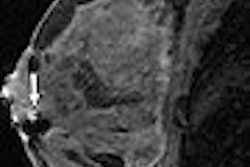Niche MRI developer MagneVu of Carlsbad, CA, has filed for Chapter 7 bankruptcy liquidation. An executive for the company said the firm was weighed down by a combination of a heavy debt load and insurance payors reluctant to reimburse for scans conducted in physician offices -- MagneVu's target market.
In a filing dated September 14 with the U.S. Bankruptcy Court for the Southern District of California, the company listed liabilities of $14.9 million and assets of $611,000. The filing includes a 13-page list of creditors.
MagneVu specialized in a niche MRI scanner designed to be installed in physician offices and used for extremity applications, such as musculoskeletal imaging. The system had a field strength of 0.18 tesla, and used a design based on a nonhomogeneous magnetic field and an antenna cooled with liquid nitrogen.
MagneVu's Web site states that it has installed more than 130 systems in the U.S. The company recorded sales of $1.2 million in 2007, $2.3 million in 2006, and $3.8 million in 2005, according to the bankruptcy filing.
MagneVu had a promising technology that enabled the company to sell compact systems for about $100,000, a fraction of what a whole-body MRI scanner costs, according to Vick Stoughton, CEO of the company for the past year. The scanner could either be installed in physician offices or used as a complementary system at a site with a larger scanner for musculoskeletal applications such as imaging rheumatoid arthritis, freeing up the main system for whole-body work.
MagneVu's corporate structure, however, was based heavily on debt rather than equity, and the company needed to generate significant profit to service its debt load, Stoughton said. The firm was never really able to service its debt load, and as a result debt continued to accumulate on the company's balance sheet.
At the same time, the increased scrutiny of physician in-office imaging made many insurance payors reluctant to reimburse for scans conducted on the systems, Stoughton said. Payors typically classified the scanner as experimental to avoid having to pay for studies, and the company never had the resources to conduct clinical studies that would validate the technology.
"Because this technology represented the possibility of more fees being paid for MRI, a lot of third parties were taking the position that it was experimental," Stoughton said.
About 90 scanners are still in use, according to Steven Ford, president of Professional Imaging Services, a San Diego-based equipment service firm. The firm services about 60 MagneVu systems, and is offering to cover the unexpired warranties and prepaid service contracts for a limited time for MagneVu customers.
"We have a large store of spare parts, and we also reprocess and recertify used parts," Ford said. "We will keep these machines running as long as people want to use them."
Stoughton believes there is still a promising market for MagneVu's technology, particularly in international markets. The company was working on a new generation of designs before the bankruptcy filing occurred, but needed $2.5 million to $6 million to finish the work.
It's possible that MagneVu's intellectual property could find its way into other MRI scanners when the bankruptcy proceedings are completed, a process that Stoughton estimates will wrap up in the next several months.
"The smart move would be to take the patented technology, put together a business case, raise venture capital, and put together a business plan -- sell equity, don't take debt on," Stoughton said. "And I think there is an opportunity. The technology is interesting in that you can do MR imaging, at a much lower cost, simply because of the nonhomogeneous magnet."
By Brian Casey
AuntMinnie.com staff writer
October 9, 2007
Related Reading
GE inks MRI deal with MagneVu, October 20, 2003
MagneVu, Diagnostic Imaging ink distribution deal, September 18, 2002
MagneVu adds financing option, February 20, 2002
Copyright © 2007 AuntMinnie.com


.fFmgij6Hin.png?auto=compress%2Cformat&fit=crop&h=100&q=70&w=100)





.fFmgij6Hin.png?auto=compress%2Cformat&fit=crop&h=167&q=70&w=250)











